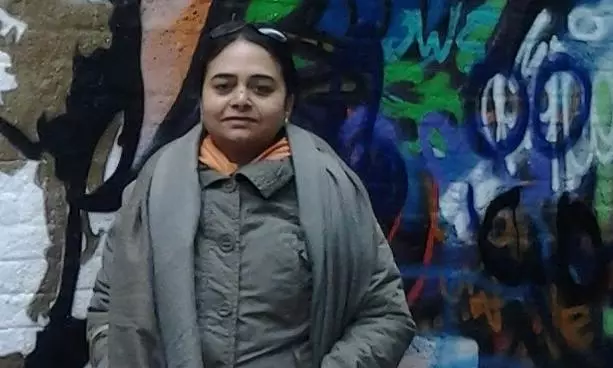In love with the wild!

An electrical engineer who designs earthing and lightning protection systems, Masood Hussain began his photography journey like any other beginner — shooting anything and everything he saw. “It soon became monotonous and boring. I wanted to do something challenging and unique. Then I read that birds are some of the most difficult subjects to photograph because they are extremely sensitive. To get a decent shot of a bird, you need to get very close to it, without bothering it, and allowing to become aware of your presence. I started enjoying the process and eventually fell in love with my subjects. Spending time in the wild has now become second nature to me,” he says. The wildlife photographer recently held his maiden exhibition, Meraki, which is Greek for ‘passion for one’s work’.
 White-throated kingfisher
White-throated kingfisher
“Meraki by mh is a set of images that tell a story of an event that occurred in the wild. Images that aren’t captured, but made with the heart and soul,” says Masood. The exhibition is intended to make people feel connected to nature, and create awareness about the conservation of wildlife. The photographer is extremely pleased with the response he has received. “18 of the 22 prints exhibited were sold.” Masood now wants to take his talents to schools in Hyderabad. He believes that children, the torch-bearers of the future, need to be introduced to the fast-depleting natural treasures of our jungles.

An alumnus of Hyderabad Public School, Masood attributes his success to his alma mater. “The HPS emblem bears an eagle, and its alumni are called eaglets. The school’s slogan, ‘Be Vigilant’ is an important lesson for life, and wildlife photography,” says the 41-year-old lensman who was awarded the distinction AFIAP by the International Federation Of Photographic Art, France, and a recipient of The Natural Capital Award 2017. So how does the photographer locate his subject? He decides where to go looking for them based on the time of year. “Summer is the best time to photograph mammals such as tigers and leopards, as there is a high probability of locating them near watering holes.

At other times of the year, water is abundantly available all around the jungle and the tall grass reduces visibility. To photograph birds, you need to have knowledge about their habitat, distribution and migration pattern. Some species are winter visitors, while others are passage migrants making a short stop along their journey. Monsoon is when reptiles breed, and so it is the best time to photograph snakes, lizards and geckos,” Masood says. The photographer believes that in wildlife photography, failure is not an option; once a moment is lost, it is gone forever. “There are times when I miss shots, often due to conditions beyond my control. For example, there may not be sufficient light. The capabilities of your equipment can also limit you from getting a shot. I remember waiting with my eye on the viewfinder for 45 minutes to capture a Himalayan Monal taking off. When the bird finally took off, my camera battery died. I felt bad for a while, but I have no regrets. Every day is a new day, it’s all part of the game.”
 Himalayan monal
Himalayan monal
“Gone with the fish”, one of Masood’s best pictures, captures an Osprey taking off with a half-eaten fish in its mouth, on the River Zuari in Goa. Speaking about one of the most dangerous situations he has encountered while on assignment, Masood says, “I recently shot a Schneider’s Leaf-Nosed Bat in flight. It is probably the first image of its kind shot in India, of the species in its natural habitat. We were stationed in a cave infested with snakes.

Oxygen levels were extremely low, and it was pitch dark; we would rush out gasping for breath every few minutes. We had no anti-venom with us, and the closest hospital was about four hours away, which means that a snake bite could be fatal. That was one of the toughest conditions I have had to work under. But I enjoyed every bit of the process, and the effort did pay off.” Masood believes that wildlife photography has taught him patience. “Spending time in the wild is a form of meditation for me. I have learnt to appreciate the finer things in life. Photography has taught me to look at things differently, to be considerate and compassionate.”
 Oriental dwarf kingfisher
Oriental dwarf kingfisher

Most beautiful place
The Jim Corbett National Park is his favourite jungle in India. “A perfect Jungle Book setting. Located in the foothills of the Himalayas, it is extremely picturesque. One can find every type of habitat here, grasslands, dense canopies, lakes, rivers. Amazing biodiversity,” says the soft-spoken lensman.
BREAKTHROUGH MOMENT
I was photographing Himalayan Pit Viper when I saw two spiders sparring right on top its head. All I knew was if I could pull it off, this might as well be an award winner. To get an extreme close up, the situation demanded me to be well within the striking range of the snake. Took a macro shot from 12 inches from its head. The resulting image titled ‘Bizarre Arenas’ was indeed an award winner for which I received the Natural Capital Award 2917.
FAVOURITE LOCATION
Himalayas, undoubtedly. God has been very generous when it imparted colours to the Himalayan birds. They are extremely colourful. The light in this region is magical and changes every few minutes. The backgrounds one gets is to die for. There is so much peace there. I can spend hours looking at the snow-capped peaks beautifully illuminated by the sun rays filtered through low flying clouds.

